The C8 XLT Optical Tube
The Celestron CGEM II 800 8” SCT package features the Celestron C8 XLT optical tube, an 8” (203mm) f/10 Schmidt-Cassegrain telescope with a focal length of 2032mm, which can be reduced to 1280mm and f/6.3 with the Celestron f/6.3 focal reducer or to an f/2 400mm system with a Starizona HyperStar kit, the latter configuration being similar to the Celestron 8” RASA.

The Celestron C8 XLT is the latest iteration of the company’s classic 8″ Schmidt-Cassegrain telescope design. The C8 has been in use since 1970 and has seen few changes in terms of design or performance since then, although the coatings and manufacturing process have been updated, with the newest version having Celestron’s StarBright XLT coatings for slightly better light transmission as well as compatibility with the Starizona HyperStar system. The C8 XLT’s legacy design has an undersized interior baffle, which prevents it from illuminating the entire field of a 2” eyepiece or large camera sensor, limiting it to a true field of about 1.1 degrees. The EdgeHD version fixes this problem as well as providing a flatter field of view and a few other upgrades. However, for visual observers, planetary imagers, or people with less demanding astrophotography requirements, the C8 XLT is just fine and delivers excellent sharp views at the eyepiece as well as pinpoint stars when focused and collimated correctly.
I find collimating the C8 XLT fairly easy as it involves adjusting three screws to tip and tilt the secondary mirror. This is a fairly infrequently-required process, and our collimation guide explains more. Focusing the C8 XLT, as with all of Celestron’s Schmidt-Cassegrain telescopes, is achieved with a knob at the back of the telescope, which moves the primary mirror and shifts the focal plane dramatically. This design can cause “image shift,” where the view appears to rock back and forth as the focus is adjusted, but newer C8 XLTs don’t have much of this problem. However, over long time spans (such as a few hours during a photographic exposure), the mirror can flop on its support and cause blurry stars as the frame either tilts or shifts out of focus. This is a major disadvantage for those who want a no-fuss astrophotography setup; the EdgeHD 8 has locks to prevent the problem and as such is a better choice for deep-sky astrophotography.
Accessories such as visual backs, focal reducers, and camera adapters can be attached directly to the SCT threaded port at the back of the C8 XLT’s tube. The C8 bundled with the CGEM II 800 package comes with a CGE-style dovetail rail to fit the CGEM II or any other mount compatible with a CGE or Losmandy D-style plate, along with holes at the top drilled for a second dovetail and a carry handle on the back of the tube for easy transportation.
Accessories
The CGEM II 800 package includes a 6×30 finderscope, acceptable for the purposes of a GoTo alignment, though offering a fairly dim view compared to a larger 50mm finder. The scope also includes a standard 1.25” visual back, 1.25” prism star diagonal, and a 25mm focal length, 1.25” diameter E-Lux Plossl eyepiece with a 52-degree apparent field of view, yielding 81x and a true field of 0.65 degrees – slightly larger than the angular diameter of the full Moon – with the C8 XLT. You will almost certainly want additional eyepieces for the C8 XLT, offering higher and lower magnifications for a wider field of view (which may also require the purchase of an f/6.3 reducer or 2” star diagonal).
The CGEM II Equatorial Mount
The CGEM II is Celestron’s mid-range equatorial mount between the cheap Advanced VX and the much higher-quality CGX. The CGEM II shares many of the mechanics and flaws of the Advanced VX, such as its tripod, counterweight shaft, and cheap servo motors. The CGEM II’s stated weight capacity of 40 lbs. means that about half that weight is suitable for imaging purposes. As such, it is near its limits for handling long-exposure astrophotography with the C8 XLT telescope and f/6.3 reducer or f/2 HyperStar conversion. Although the CGEM II is an acceptable option for such purposes, it is not the best choice for dedicated imaging, and the Sky-Watcher EQ6Ri Pro or another mount like the Celestron CGX or Losmandy G11 would be a better option. Our review of the CGEM II goes into further detail about its flaws when used for imaging.
The CGEM II has a dual dovetail saddle capable of accepting Vixen, Losmandy, and Celestron CGE style dovetail plates, the latter of which is used with the provided C8 XLT optical tube. The CGEM II uses a standard ¾” counterweight shaft and comes with a single 17 lb counterweight to balance the C8 XLT, with plenty of margin for additional weight from accessories. You can connect the mount to your PC with a MicroUSB cable and control it with software such as NINA via ASCOM drivers, and a standard ST4 port is built in for an autoguider, which you’ll need for deep-sky imaging with the CGEM II and any telescope. Additionally, the CGEM II mount allows you to connect add-ons such as Celestron’s StarSense AutoAlign, SkySync GPS, and SkyPortal WiFi adapter. You can power the CGEM II with either AC or DC connectors, and a cigarette lighter DC cord is provided with the mount.
The CGEM II is easy to set up for visual use, though it’s needlessly heavy compared to the smaller Advanced VX or an alt-azimuth mount which will carry the C8 XLT just as well. After balancing the optical tube, adjusting the counterweights, and leveling the tripod, you can polar align with a polar scope or Celestron’s All-Star Polar Alignment method. With the NexStar+ hand controller or a suitable WiFi adapter/smart device, you align the mount on the sky. Simply center several alignment stars in the eyepiece and confirm them to complete the alignment process. You can then automatically slew to and track anything you select in the mount’s 40,000 object catalog.
Should I buy a Used Celestron CGEM II 800 SCT?
A used CGEM II 800 package can be a bargain; older CGEMs are similar but lack the CGEM II’s dual dovetail and some software improvements. Check to make sure that the mount powers on and operates smoothly, and that the C8 XLT telescope is free of corrosion or damage to the mirrors and corrector plate, which requires replacing the whole telescope or optical set to fix. Missing accessories, a missing hand controller, or a missing counterweight/bar are easily replaced but should accordingly result in a price reduction on a used item.
Alternative Recommendations
The Celestron CGEM II 800 SCT is not the most economical telescope for the money, nor is it the most capable for any particular task. Deep-sky astrophotographers should consider a separate mount and optical tube package such as what’s outlined in our rankings, while for visual use or planetary imaging, we’ve picked a few options that might be a better fit:
Under $1800
- The Apertura AD10/Zhumell Z10/Orion SkyLine 10 offers an impressive array of features for an incredible price. It has more aperture, more accessories, and a much simpler mount than the CGEM II 800 SCT.
- The Apertura AD12/Zhumell Z12/Orion SkyLine 12 offers over double the light-gathering power and 50% more resolution than the CGEM II 800 SCT, along with the same accessories and features of its 10” and 8” counterparts, but is a bit less convenient to set up and transport due to its massive solid tube.
- The Sky-Watcher 10” GoTo Collapsible Dobsonian is perfect for those looking for something more portable, as the collapsible tube makes it easier to transport. Plus, it can be controlled via your smartphone/tablet and also features Sky-Watcher’s FreedomFind technology to allow for manual aiming if the telescope’s electronics are in use, without any interference with its GoTo functionality.
$1800+
- The Sky-Watcher 12” Collapsible Dobsonian is fairly compact when disassembled thanks to its collapsible tube and is available in both manual and GoTo versions, with the latter offering the same smartphone operability and FreedomFind encoders as the 10” Collapsible model.
- The Celestron Advanced VX 9.25” SCT is more capable than the CGEM II 800 for visual use or planetary imaging but is easier to transport and set up, with a lighter weight equatorial mount than the CGEM II and a minimally larger optical tube compared to the C8 XLT in size or weight.
- The Celestron NexStar Evolution 8” has the same optical tube as the CGEM II 800 but is dramatically cheaper, easier to set up and use, and more compact. You can also get an EdgeHD version with StarSense auto-align technology for an even more convenient setup if you wish.
Aftermarket Accessory Recommendations
The standard Celestron 0.63x focal reducer is necessary for any deep-sky imaging with the C8 XLT. It screws onto the back of the tube ahead of your camera or adapters and brings the scope down to f/6.3 and a focal length of 1280mm. You can also use a focal reducer for visual astronomy with the C8 XLT, but a 2” star diagonal and eyepieces are usually the preferred choice for achieving a wider field of view. If you choose the latter, Apertura’s 38mm SWA (53x) and 2″ dielectric screw-on diagonal are perfect for your needs. The 38mm SWA will have vignetting towards the edges of the field of view with the C8 XLT but offers a roughly 1.1-degree unvignetted true field. Additionally, a good UHC nebula filter, such as the Orion UltraBlock, will improve your views of nebulae with the C8 XLT under almost any conditions.
The C8 XLT can handle up to 300-400x magnification on a steady night, and you’ll want to be able to achieve a range of magnification with additional 1.25″ oculars, starting with a medium power eyepiece such as Apertura’s 15mm SWA (135x) or Explore Scientific’s 14mm 82-degree (145x). Explore Scientific’s 8.5mm 82-degree (239x) or, alternatively, a 9mm redline or goldline (226x) are both excellent choices for higher power eyepieces. You could also use a medium-power ocular with a Barlow lens in lieu of a high-power eyepiece if you are planning on getting a Barlow for planetary imaging purposes anyway.
The C8 XLT can benefit from the use of a dew shield to prevent condensation from forming on the front Schmidt corrector plate. Dew can not only obstruct views/images, but its contents—namely, trace acids and other chemicals from industrial processes or pollen—can damage the StarBright XLT coatings or even the glass itself composing the corrector. Additionally, adding a dew shield can help to reduce stray light entering the telescope, improving contrast, and protecting the corrector plate from accidental touches and fingerprints. A flexible dew shield is inexpensive, can be rolled up for storage/transport, and is all that most people will need. However, a heated plastic or metal dew shield may be necessary for more humid climates.
A polar scope or PoleMaster is a must for the CGEM II regardless of what you are using it for, as accurate polar alignment cannot be otherwise obtained except with All-Star Polar Align. Additionally, either an AC adapter or a rechargeable power supply such as the Celestron PowerTank Lithium Pro is necessary to use the CGEM II.
For imaging, a motor focuser and Bahtinov mask are highly recommended for use with the C8 XLT; Starizona’s HyperStar conversion is also available to bring the C8 XLT to f/2. However, the 8” RASA already includes this conversion and is cheaper, so a HyperStar is probably not worth purchasing. You will also need an autoguider setup in the form of a suitable guide camera and either a guide scope/off-axis guider for deep-sky astrophotography.
What can you see?
The C8 XLT telescope has a relatively small maximum unvignetted field of view of 1.1 degrees when using either a 2” wide-angle ocular or 1.25” eyepiece and f/6.3 reducer, which is much smaller than the 2-degree field of view that 8-10” Dobsonian telescopes can achieve and slightly smaller than the full 2” unvignetted field of 1.3 degrees that can be achieved by the EdgeHD 8”. While larger open star clusters and nebulae may not be ideal to view with the C8 XLT as a result of this limited field size, some of the smaller open star clusters are spectacular in the eyepiece, as well as many of the brighter globular star clusters from the Messier catalog, which display individual stars at high magnifications. Smaller planetary nebulae like the Ghost of Jupiter Nebula and Cat’s Eye Nebula show many details and colors, while larger emission nebulae such as Orion (M42), the Lagoon (M8), and the Swan (M17) can still be seen in great detail, especially under dark skies, and are further enhanced with a UHC filter.
Under light-polluted skies, galaxies viewed through the C8 XLT or really any telescope will appear as little besides washed-out smudges and are often hard to see at all. However, if you transport the telescope to a darker location, you can begin to resolve details such as hints of spiral arms, dust lanes (by far the easiest details to observe on account of their high contrast), and H-II regions in brighter galaxies from the Messier and NGC catalogs. Additionally, you can observe many galaxy groups and the various huge galaxy clusters in Virgo, Leo, Fornax, and Coma Berenices.
With the C8 XLT, you can get stunning views of the Moon and planets. The phases of Mercury and Venus, as well as dark markings and polar ice caps on Mars, are clearly visible. Jupiter’s cloud belts and the Great Red Spot show up sharp and colorful, with its four Galilean moons visible even at the 6×30 finder. At high power during frequently-occurring transits, the C8 XLT reveals their small disks along with their shadows moving across the planet’s cloud belts. Saturn’s rings, cloud belts, and a handful of moons are visible. The Cassini Division in Saturn’s rings can also be observed on a typical night of good seeing, as well as the Encke gap on an exceptional night. Uranus and Neptune show little besides their tiny round disks, with a couple of Uranus’ moons barely visible and Triton showing up fairly conspicuously next to Neptune. It is technically possible to observe Pluto with an 8” telescope like the C8 XLT under dark skies, and the CGEM II will easily locate it for you, but Pluto is already on the verge of being too dim for the most seasoned observers to spot and will continue to lose brightness as it grows more distant from the Sun.
Astrophotography Capabilities
If you’re looking to use the C8 XLT and CGEM II for deep-sky astrophotography, it can produce good results with almost any camera if an f/6.3 reducer and a suitable autoguider are used. However, due to the C8’s baffle tube diameter and the inherent mirror flop issues in the telescope’s focuser, it is inferior to the C8 EdgeHD, which removes these constraints and only costs a bit more. A Starizona HyperStar will enable you to shoot with the C8 XLT at 400mm focal length, which increases tolerance for tracking errors and provides a very wide field. However, this option is expensive, and you are limited to using certain one-shot-color CMOS cameras and small sensor sizes with this configuration. If you’re looking to use a larger aperture and focal length telescope like the C8 XLT for deep-sky astrophotography, an 8” EdgeHD or smaller refractor or Newtonian reflector astrograph designed for imaging, would be a better choice. The 8” RASA, available on its own or bundled with the CGEM II or Advanced VX, has HyperStar built in and provides superior results to the C8 XLT with HyperStar installed for a lower price if you are dedicated to shooting at 400mm focal length.
If you’re looking to do planetary imaging, the C8 XLT telescope is a great choice, though of course, a larger scope can resolve more under good seeing conditions. To get the most out of the C8 XLT for planetary imaging, you’ll need to pair it with a 2x to 3x Barlow lens, which boosts its focal length to between 4000mm and 6000mm for optimal image scale. You’ll also need a high-speed planetary video camera, such as the ZWO ASI224MC (which also doubles as a guide camera), and a laptop. With this setup and good seeing conditions, you can take beautiful photos of the Moon, Venus, Mars, Jupiter, and Saturn.



